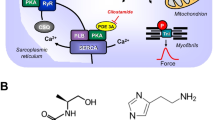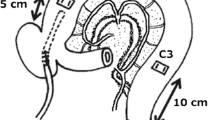Summary
The effects of 5-methoxytryptamine and 5-hydroxytryptamine (5-HT) on both basal and electrically evoked outflow of tritium were studied in guinea-pig myenteric plexus preparations preincubated with [3H]-choline.
Basal outflow. 5-Methoxytryptamine caused a transient and calcium-dependent increase in basal outflow of [3H]acetylcholine that was abolished by tetrodotoxin. Ondansetron (1 μmol/1) did not affect the stimulatory response of 5-methoxytryptamine but ICS 205-930 (1 and 3 μmol/1) produced parallel rightward displacements of the concentration-response curve to 5-methoxytryptamine. The PKB value for ICS 205-930 was 6.6 suggesting an involvement of 5-HT4 receptors. 5-HT caused an increase in basal outflow of [3H]acetylcholine and a biphasic concentration-response curve was obtained. The maximal response of the first phase to 5-HT (release of 0.98% of tissue tritium) and the maximal response to 5-methoxytryptamine (0.94% of tissue tritium) were similar but 5-methoxytryptamine (-log EC50: 6.9) was less potent than 5-HT (-log EC50 of the high affinity component: 7.9). ICS 205-930 (0.01–1.0 μmol/1) acted as a competitive antagonist against the low affinity component of the 5-HT concentration-response curve with a pA2 value of 8.0. It is concluded that stimulation of both 5-HT4 receptors (by 5-methoxytryptamine and submicromolar concentrations of 5-HT) and 5-HT3 receptors (by micromolar concentrations of 5-HT) causes a release of acetylcholine which in turn leads to smooth muscle contraction.
Electrically evoked outflow. This outflow of [3H]acetylcholine was concentration-dependently inhibited by both 5-methoxytryptamine and 5-HT. ICS 205-930 (1 μmol/1) reinforced the inhibitory effect of 5-methoxytryptamine but not that of 5-HT. In the presence of methiothepine (0.1 μmol/1) 5-methoxytryptamine enhanced the evoked outflow of [3H]acetylcholine, an effect which was attenuated by 3 μmol/1 ICS 205-930. These results suggest that 5-methoxytryptamine may both inhibit (via 5-HT1 receptors) and facilitate (via 5-HT4 receptors) the evoked release of acetylcholine from guinea-pig myenteric neurones. The facilitatory action is unmasked when the 5-HT1 receptor is blocked by methiothepine.
Similar content being viewed by others
References
Arunlakshana O, Schild HO (1959) Some quantitative uses of drug antagonists. Br J Pharmacol Chemother 14:48–58
Baxter GS, Craig DA, Clarke DE (1991) 5-Hydroxytryptamine4 receptors mediate relaxation of the rat oesophageal tunica muscularis mucosae. Naunyn-Schmiedeberg's Arch Pharmacol 343:439–446
Buchheit KH, Engel G, Mutschler E, Richardson B (1985) Study of the contractile effect of 5-hydroxytryptamine (5-HT) in the isolated longitudinal muscle strip from guinea-pig ileum. Evidence for two distinct release mechanisms. Naunyn-Schmiedeberg's Arch Pharmacol 329:36–41
Butler A, Hill JM, Ireland SJ, Jordan CC, Tyers MB (1988) Pharmacological properties of GR38032F, a novel antagonist at 5-HT3 receptors. Br J Pharmacol 94:397–412
Chahl LA (1983) Substance P mediates atropine-sensitive response of guinea-pig ileum to serotonin. Eur J Pharmacol 87:485–489
Craig DA, Clarke DE (1990) Pharmacological characterization of a neuronal receptor for 5-hydroxytryptamine in guinea pig ileum with properties similar to the 5-hydroxytryptamine4 receptor. J Pharmacol Exp Ther 252:1378–1386
Craig DA, Eglen RM, Walsh LKM, Perkins LA, Whiting RL, Clarke DE (1990) 5-Methoxytryptamine and 2-methyl-5-hydroxytryptamine-induced desensitization as a discriminative tool for the 5-HT3 and putative 5-HT4 receptors in guinea pig ileum. Naunyn-Schmiedeberg's Arch Pharmacol 342:9–16
Derkach V, Surprenant A, North RA (1989) 5-HT3 receptors are membrane ion channels. Nature 339:706–709
Dumuis A, Bouhelal R, Sebben M, Cory R, Bockaert J (1988) A nonclassical 5-hydroxytryptamine receptor positively coupled with adenylate cyclase in the central nervous system. Mol Pharmacol 34:880–887
Dumuis A, Sebben M, Bockaert J (1989) The gastrointestinal prokinetic benzamide derivatives are agonists at the non-classical 5-HT receptor (5-HT4) positively coupled to adenylate cyclase in neurons. Naunyn-Schmiedeberg's Arch Pharmacol 340:403–410
Eglen RM, Swank SR, Walsh LKM, Whiting RL (1990) Characterization of 5-HT3 and ‘atypical’ 5-HT receptors mediating guinea-pig ileal contractions in vitro. Br J Pharmacol 101:513–520
Elswood CJ, Bunce KT, Humphrey PPA (1991) Identification of putative 5-HT4 receptors in guinea-pig ascending colon. Eur J Pharmacol 196:149–155
Fozard JR (1985) 5-Methoxytryptamine (5-MeOT) discriminates between excitatory neuronal 5-hydroxytryptamine (5-HT) receptors in the guinea-pig ileum. J Pharmacol (Paris) 16:498
Fozard JR (1990) Agonists and antagonists of 5-HT3 receptors. In: Saxena PR, Wallis DI, Wouters W, Bevan P (eds) Cardiovascular pharmacology of 5-hydroxytryptamine. Kluwer, Dordrecht, pp 101–115
Fozard JR, Kilbinger H (1985) 8-OH-DPAT inhibits transmitter release from guinea-pig enteric cholinergic neurones by activating 5-HT1A receptors. Br J Pharmacol 85:601P
Fox AJ, Morton IKM (1990) An examination of the 5-HT3 receptor mediating contraction and evoked [3H]-acetylcholine release in the guinea-pig ileum. Br J Pharmacol 101:553–556
Kaumann AJ, Sanders L, Brown AM, Murray KJ, Brown MJ (1991) A 5-HT4-like receptor in human right atrium. Naunyn-Schmiedeberg's Arch Pharmacol 344:150–159
Kilbinger H, Pfeuffer-Friederich I (1985) Two types of receptors for 5-hydroxytryptamine on the cholinergic nerves of the guinea-pig myenteric plexus. Br J Pharmacol 85:529–539
Reeves JJ, Bunce KT, Humphrey PPA (1991) Investigation into the 5-hydroxytryptamine receptor mediating smooth muscle relaxation in the rat oesophagus. Br J Pharmacol 103:1067–1072
Richardson BP, Engel G, Donatsch P, Stadler PA (1985) Identification of serotonin M-receptor subtypes and their specific blockade by a new class of drugs. Nature 316:126–131
Sanger GJ (1985) Three different ways in which 5-hydroxytryptamine can affect cholinergic activity in guinea-pig isolated ileum. J Pharm Pharmacol 37:584–586
Sanger GJ, Nelson DR (1989) Selective and functional 5-hydroxytryptamine3 receptor antagonism by BRL 43694 (granisetron). Eur J Pharmacol 159:113–124
Schlicker E, Fink K, Göthert M, Hoyer D, Molderings G, Roschke I, Schoeffter P (1989) The pharmacological properties of the presynaptic serotonin autoreceptor in the pig brain cortex conform to the 5-HT1D receptor subtype. Naunyn-Schmiedeberg's Arch Pharmacol 340:45–51
Tonini M, Galligan JJ, North RA (1989) Effects of cisapride on cholinergic neurotransmission and propulsive motility in the guinea pig ileum. Gastroenterology 96:1257–1264
Wallenstein S, Zucker CL, Fleiss JL (1980) Some statistical methods useful in circulation research. Circ Res 47:1–9
Author information
Authors and Affiliations
Additional information
Send offprint requests to H. Kilbinger at the above address
Rights and permissions
About this article
Cite this article
Kilbinger, H., Wolf, D. Effects of 5-HT4 receptor stimulation on basal and electrically evoked release of acetylcholine from guinea-pig myenteric plexus. Naunyn-Schmiedeberg's Arch Pharmacol 345, 270–275 (1992). https://doi.org/10.1007/BF00168686
Received:
Accepted:
Issue Date:
DOI: https://doi.org/10.1007/BF00168686




